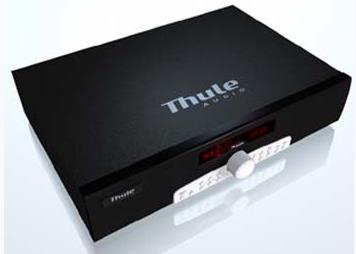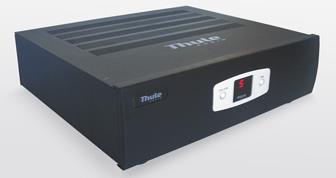|
||||||||
|
Introduction I have been looking at stepping into the world of separates, but before I drop my hard earned money, I want to make sure I am getting something that is a significant upgrade. Step one is trying out some of the best equipment I can get my hands on, even if it may be outside of my budget.
Enter the Thule Audio PR350B SSP and PA350B
five-channel power amplifier. With an MSRP of
$4,799 for the PR350B, and $4,999 for the PA350B, they are much more
expensive than my current Pioneer 53tx receiver. The SSP and amplifier are both cleanly designed, black, with tasteful silver faceplate and red LED displays. I was taken aback by just how compact the combo is. The amp weighs in at only 44 pounds, and the SSP at just over 14 pounds.
Each channel of the SSP uses dual differential DACs (Burr-Brown PCM 1738Es). Because of the dual differential DACs, it would have been nice to get XLR outputs for all channels to take full advantage of this (there are only two), especially since there are many power amplifiers out there with balanced inputs and full balanced operation. Separate power transformers handle analog and digital signal paths. Much of the small size of the amplifier is due to what Thule calls “Virtual Class A” high efficiency design. While it is great to have a more compact design, all is not roses. One of the drawbacks is that the amplifier uses a higher idle current than a Class A/B amp, causing the idle temperature to reach about 1200 F in a normal room. The upside is that Class A operation is the highest quality.
The PA350B has two 500 VA toroidal transformers and 120,000 F of capacitance. When connected to the PR350B SSP, the amplifier will automatically switch to two-channel operation when the stereo mode is activated. This changes the output to 2x350 watts into 8 ohms instead of 5x120 watts. The LED readout panel on the front of the amplifier tells you what the status is (5 channel operation or 2 channel). As an option, you can add a sixth and seventh channel amplifier module for 7.1 configurations.
Thule recommends putting the amp
in Standby Mode (button on amp face) when not in use. In addition, they
recommend waiting 20 minutes after coming out of standby or 4 hours from a
hard switch off before optimum sound quality is reached. PR350B SSP:
Inputs: There are four input banks that feature S-Video, composite video, and L and R RCA audio jacks. Two additional inputs feature S-Video, component video and Toslink audio. There are also four digital coaxial inputs. There is a direct digital audio link input for DVD-A, which appears to be similar to a CAT-5 type network connection. There are six RCA analog inputs for multi-channel input (5.1). There is also a pair of XLR balanced audio inputs for stereo.
Outputs: Two S-Video, two composite video, and one set of component video
outputs are present. In addition, there are eight RCAs for analog multi-channel, a pair
of XLR balanced, a pair of RCAs for Zone 2, and a Toslink optical digital audio for
output. In addition there is an RS-232 and a data I/O for controlling a
Thule amp. PA350B Amplifier:
The amplifier has seven multi-channel RCA style audio inputs and a
sub-out (formed from the front left and right inputs). There are also stereo
inputs in the form of two RCA style (unbalanced) and two XLR style (balanced).
A data I/O connection allows communication with the
PR350B or PR250B SSPs. This is useful for switching from stereo to
multi-channel mode and going into standby using the SSP remote. The five
sets of speaker binding posts are sturdy.
The remote reminds me distinctly of the 80's Zenith TV
remotes, with all one type of button, and a silver back plate. Functionally,
it worked OK, but responsiveness was not very good, and the remote
needed to be pointed directly at the SSP. Thankfully, Thule recognizes this
shortcoming and offers a Pronto remote upgrade. Thule's remote rationale?
Why spend money on something that will just be replaced by a high end remote
anyway? I would have to agree that at these price points, the typical user will most likely have at the very least
an aftermarket remote and most likely a full custom install. This was my first experience with a high end European manufacturer. To be honest I had a number of issues during setup. My biggest one was due to not reading a line in the manual that said there were two pages to the configuration menu. The number of manuals I have had to read in order to set up a piece of electronic equipment is precisely two, this one, and the Yamaha DVD-2300 for SACD setup. There is no arrow on the OSD or anything else to let you know that there is a second page, so I just assumed there was none. Once that was clear, things progressed much better and I was able to at least reach full functionality with all my other equipment. I was a little disappointed that there was no input renaming of any type. So, I set my XBox as "Tape 2", and Gamecube as "TV". Volume is a relative scale with 0 being no volume and 100 being max, in 0.5 dB steps, so there is no setting of reference level at 00. There are no processing fields or modes of any kind. All DD and DTS sources are straight through with no DSP modes. There is no auto detection and switching for the video or audio input types. Every single component must be hard chosen in the menu or the SSP will not display or output it. With the analog inputs, you are given a choice as to what type of processing: Stereo, Pro Logic II Movie or Pro Logic II Music. The movie/music distinction must be chosen through the configuration setup menu.
So, the SSP is typical Danish Spartan design (quality
over quantity), but there
are a number of nice and somewhat less common options available. There is
support for Dolby Pro Logic II (no IIx), DTS ES and 24/96. Also the dynamic range compression has a number of options, from
boosting low output level bass, to peak limiting, both with six steps of
control. In addition, crossover frequency is selectable from 60 Hz to 110
Hz, in 10 Hz steps. A really cool feature is the ability to save
entirely different and separate configuration setups for DD, DTS, DPL-II,
and Stereo. I lined up some of my reference material, A Perfect Circle's 13th Step, Norah Jones's Come Away With Me, Beck's Sea Change and added in Green Day's American Idiot. For a pop-punk album, American Idiot is fairly well recorded. However, compared with the rest of my reference material, it is over-processed and a bit edgy. I felt this would give me a little better perspective on a wider range of material. I really wished I still had the Denon DVD-3910 in for a good analog source; however I made do with the Denon DVD-2200 which was filling in at the moment. I did a two stage A/B, first using the DVD player's analog outs against the Thule SSP's decoding of the coax digital stream. The second stage was repeating the same test with the Pioneer Elite 53tx receiver functioning as an SSP only. In earlier testing, I subjectively found the 53tx digital-to-analog decoding from the coax digital to be well below that of the Denon DVD-3910, and on par with the DVD-2900 and Yamaha 2300. In this case, the 53tx did quite a bit better than the DVD-2200: both had similar tonal balance, but the 2200 had more of an edge and graininess that was most apparent on American Idiot. This characteristic was still present in the acoustic material like Norah Jones, but mostly in the decay of cymbals. Now for the real question: where would I put the Thule PR350B SSP's digital decoding in the mix? Well, it is hands down better than the Denon DVD-2200, and fairly close to the Pioneer 53tx, and not as good as the DVD-3910. The highs sounded a bit darker, maybe a little warmer in comparison to the other equipment I have recently used. In addition, the midrange was smoother with a less digital sound than the Pioneer, a definite plus. On the other hand, a chip upgrade for the Thule . . . .
A New Chip and Further Sound Impressions After I had completely removed the Thule equipment from my setup, I was informed that the Thule engineers had developed a new EPROM that addressed a couple of my concerns. Removing the top cover and replacing a chip accomplished the upgrade. The big change was now the nearly unforgivable offense of being forced into Pro Logic processing using stereo RCA analog inputs was corrected. In addition, the mute control was given the option of attenuation or complete mute. To check the changes and do some more listening comparisons, I took another approach to evaluating the PR350B. I used the analog outputs on the PR350B to the analog direct inputs on my Pioneer 53tx (effectively making the Pioneer an amp only). Then I connected a Denon DVD-2910's digital outputs to both the Pioneer and Thule. I set up both systems exactly the same, using the speakers in full range, stereo only with no extra processing. Even though the adjustment levels for each only allowed for 0.5 dB increments, I managed to get the levels balanced within 0.25 dB. In this way, I was able to get nearly instantaneous switching between the Thule PR350B processing and the Pioneer 53tx processing, both using the amp section of the Pioneer. I narrowed down my listening tests and only used American Idiot and Mark Knopfler's Ragpicker's Dream. Overall, my impressions didn't change too much. I did have a bit of a cold, which typically will bias me a bit toward more laid back presentations (treble can irate me a bit with a cold). Able to complete very quick A to B comparisons, I found the Thule midrange was smoother and more a bit more natural than the Pioneer 53tx, while the upper end had a little less energy.
Overall, the
sound of the Thule SSP and power amplifier was good, I'd say an upgrade, with a little smoother sound
and a bit taken off the top end. Again this is just my opinion, and as with
any audio component, especially in this price range, I suggest you listen
for yourself. The smoother midrange, and seeming attenuation of the high
frequencies, are characteristic of high end audio compared to mass market
when you listen to them side by side, because the negative feedback used in
mass market receivers emphasizes the edges of the sound, and you think you
are getting more detail, as well as more high frequency information. On the whole, the
high end product is usually the more accurate, but you have to get used to
hearing it that way.
The Thule Audio PR350B SSP was a disappointing piece of
audio equipment for me. I found the PR350B too limited and lacking in
flexibility, and it had a number of issues with setup ergonomics. Although
the combination of the PR350B and PA350B has a more natural midrange, the SSP has no support for IEEE-1394, no DVI, or HDMI
switching, and has limited processing and configuration capabilities and
connections. So, I really feel there are better options out there in
terms of SSPs,
especially at this price range. The Thule Audio PA350 Amplifier definitely has more merit. While it is very
expensive for the amount of power it produces, it does have a smooth sound,
and its compact design allows for
a much greater installation flexibility compared to other products.
|
||||||||







 Remote
Remote



